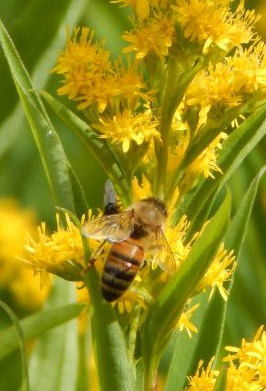25 Fascinating Facts About Honey
Updated: 3 Nov 2022
Some general
honey facts, but to learn more facts about honey bees themselves, see the
link below.
General Honey Facts
- Honey is the
only food made by an insect, and eaten both by the insect and humans.
- Honey is made from nectar and a bee enzyme, that has been stored in honey combs and has gone through a fermentation process.
- Foraging bees
have to fly about 55,000 miles to produce a pound of honey, visiting around 2
million flowers.
- Honeydew honey is honey made by honey bees from aphid secretions - actually sort of 'aphid poop'.
- Natural honey
also contains flower pollen grains. The study of pollen in honey is called 'melissopalynology'.
- Honey will
keep indefinitely in a jar. However, it
can react to cool temperatures by crystallizing. Read about crystallised honey.
- Honey is the wax-capped
nectar food stores made by honey bees to see them through the winter. The honey purchased by humans is the food
stores harvested by beekeepers and put into jars. Learn about why honey bees make honey.

- Honey has anti-bacterial and anti-septic benefits that are so effective, there is a peer reviewed, published paper demonstrating that honey is effective against MRSA – or Methicillin-resistant Staphylococcus aureus. MRSAis ordinarily difficult to treat.
- Despite its name, research now shows that contrary to former belief, the honey badger is primarily keen on eating the brood (larvae form of honey bees) in a nest, rather than the honey itself. The honey badger is primarily a carnivore. Nevertheless, this is a great video:
- Honey is used to make mead, an ancient drink mentioned in the medieval Welsh Poem 'Y Gododdin' in the The Book of Aneirin, and the only manuscript in existence can be found at the National Library of Wales in Aberystwyth.
- Honey is not considered safe for babies, because of the risk of infant botulism. It is not suitable for people with diabetes.
- Cats cannot taste honey because they lack the taste receptors to do so.
 Honeycomb
Honeycomb- Bumble bees do not make honey in the way we think of it, but they do have their own version of honey.
- However, honey bees are not the only insect that make honey! Stingless bees of the tribe Meliponini, also make honey. In addition to bees, some exotic swarming wasp species in South America also make honey! See Do wasps make honey?
- Honey is used sometimes in beauty treatments, especially for its moisturizing and antiseptic qualities.
- Honey comes in different colors, from transparent to almost black. Darker honeys have higher antioxidant levels.
- Some honey varieties are sweeter than others.
Tupelo honey is famously sweet. It featured in the lyrics of a song by Van Morrison: "Tupelo Honey". The Tupelo honey festival is held in Wewahitchka, USA, also the location of the film “Ulee’s Gold,” starring Peter Fonda, about a Wewahitchka beekeeper. - Despite its name, Cactus Honey is not honey at all! Cactus honey is Agave Syrup, which is derived directly from the sap of the agave plant, and is not made by bees.
- Honey is slightly acidic.
Historical Honey Facts
- Perhaps one of the most bizarre honey facts relates
to the Ancient Egyptians. There are
records from 1550BC, referring to honey that was applied by women to linen in order to
prevent pregnancy.
- Rameses III,
the ancient Egyptian pharaoh, offered a river god a honey sacrifice. 30,000 lbs of honey were dumped into the
river Nile.
- Toxic honey was used in ancient warfare.
- Ancient Greek
civilizations regarded honey as a symbol of blessings, and happiness. It was also used in funerals, when honey was offered
to spirits of dead people.
- In the 1650s
in England, the gross national profit from honey was estimated by the polymath,
Samuel Hartlib, to be worth £300,000, which was a fortune at that time.
- In feudal
times in medieval Europe, honey was used as a source of revenue in the form of
a tax, and was gathered by the lords. There are records of this practice in England
in the Domesday Book, as well as records of the practice in Germany.
Similarly, in France, lords collected honey from honey hunters and beekeepers. In 1791, when the French government demanded a record of all hives for the purpose of collecting taxes, many hives were destroyed by their owners.
See - Facts About Honey Bees
Resources
- Elsewhere on this site.
- Bee by Claire Preston, Published 2006, Reaktion Books. ISBN: 9781789140484.
Did You Know?
Honey is food stored by honey bees
to see them through the winter?
Read about
Did You Know?
Toxic Honey Was Used In Ancient Warfare!

